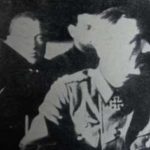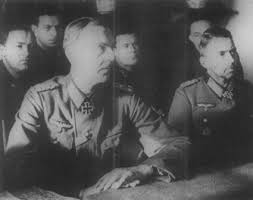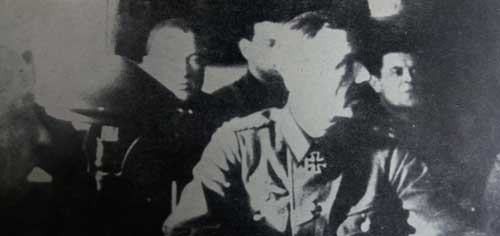 Real or 1943 ‘Photoshop’?
Real or 1943 ‘Photoshop’?
Was this photograph genuine? Hitler had his doubts. Friedrich Paulus, head of the Sixth Army in Stalingrad, was actually a Field Marshal—and German Field Marshals preferred suicide to surrender. At least, they were supposed to.
Stalingrad was going to fall – if not in August 1942 then certainly in September. Okay, October.
Hitler expected it. American diplomats in Moscow expected it. Stalin himself was pessimistic.
But the city held, aided by the very destruction heaped on it by the Luftwaffe and Nazi tanks and artillery. Urban rubble was a good working environment for the Red Army, and a lousy one for Wehrmacht tanks and soldiers.
Time, and the weather, and the indomitable Red Army were also conspiring against General Paulus and his ailing, starving, freezing, under-equipped, fuel-deprived and demoralized Sixth Army.
In November, the Red Army surrounded the Sixth Army.
Luftwaffe chief Hermann Göring had told Hitler that he could supply the Sixth Army by air, and Hitler agreed to this fantasy – one that fooled few of his staff officers. The Sixth Army was trapped in a kessel—a rapidly shrinking cauldron—and Göring’s Luftwaffe delivered a fraction of the amount promised by their commander, a fraction of what the beleaguered army required.
When surrender became imminent—so certain that even Hitler faced up to the grim reality—he promoted Paulus to Field Marshal. This was a cynical move to encourage the general to commit suicide rather than surrender (Field Marshals traditionally were not taken alive). Paulus had other ideas. On January 31, 1943, he surrendered.
Stalin sent his top cinematographer, documentary filmmaker Roman Karmen, to photograph the surrender negotiations, and when Hitler saw the published photograph, he asked his own chief photographer, Heinrich Hoffmann, if it were genuine. His hope was that Paulus had committed suicide, in which case, the surrender photo would be fake.
Hoffmann assured him that it was genuine. A photo of Paulus had not been superimposed on a separate picture. He was indeed a prisoner of the Soviet Union.
Not quite the genuine article
Paulus was questioned by top-ranking officials including General Konstantin Rokossovsky, Marshal Nikolay Voronov and General Konstantin Telegin. Captain Nikolay Dyatlenko served as translator as well as interrogator.
 Some photos of the surrender talks clearly show Paulus and, to his left, General Schmidt, surrounded by Red Army officials.
Some photos of the surrender talks clearly show Paulus and, to his left, General Schmidt, surrounded by Red Army officials.
“Karmen’s photograph was doctored in Moscow,” writes Anthony Beevor in Stalingrad. “General Telegin was removed from the print because Stalin considered him insufficiently important for such a historic occasion. (Even Dyatlenko’s promotion to major was accelerated for the release of the photograph.)”
One shot in particular, though, was taken from a different angle and looks bleached out in the top left corner.
This photo is important in that it appears in  Heinrich Hoffmann’s Hitler was my Friend. Hoffmann was the dictator’s photographer, which suggests that this “bleached” photo is a copy of the picture that appeared in Pravda. The bleached area represents the disappeared Telegin.
Heinrich Hoffmann’s Hitler was my Friend. Hoffmann was the dictator’s photographer, which suggests that this “bleached” photo is a copy of the picture that appeared in Pravda. The bleached area represents the disappeared Telegin.
Postscript: Historian Beevor notes that Telegin was terrified, justifiably, when he saw that he had been removed from the picture. During Stalin’s reign, being airbrushed out of a photograph could be the prelude to being airbrushed out of life. (Dmitri Shostakovich was similarly spooked by a critical review of his opera Lady Macbeth of Mtsensk. The reviewer was anonymous but widely believed to be Stalin. A negative review by him was potentially lethal.)
Telegin’s fears were unjustified on this occasion, but he was arrested and jailed a few years after the war ended. Eventually released, he rejoined the Army and died of natural causes, aged 82.